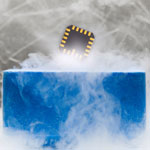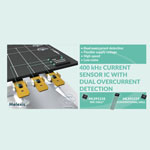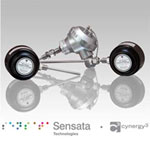Top five sensor products in June
Here, Electronic Specifier takes a look at the top five sensor products released in June.
1) Renesas Electronics has expanded its popular ZMOD4510 Outdoor Air Quality (OAQ) gas sensor platform with an IP67-qualifed waterproof package and a new AI-based algorithm that enables ultra-low power selective ozone measurements. The enhanced ZMOD4510 is the industry’s first fully calibrated, miniature digital OAQ sensor solution with selective ozone measurement capabilities, offering visibility into the air quality in users’ immediate environments for a personalised experience.
Ozone gas is a significant cause of poor outdoor air quality that poses health risks. Based on Renesas’ new ultra-low power firmware, the enhanced ZMOD4510 can detect specific ozone levels - without reporting on other pollutants - while maintaining power consumption under 200uW.
This selective measurement capability allows devices such as smart watches, phones, and smoke detectors to monitor for harmful ozone gasses typically found outdoors but which can drift indoors through open windows and doors. Optimising the ZMOD4510 for very low power is key to enabling the longer life cycles required for these types of battery-powered devices.
“Measuring outdoor air quality really is about location, location, location, as levels can vary dramatically from street to street and even on opposite sides of the same street,” said Uwe Guenther, Senior Director, Sensing Solutions, IoT and Infrastructure Business Unit at Renesas. “The enhanced ZMOD4510 gives manufacturers the selective high-precision sensing, ultra-small size, and long battery life they need for battery-powered devices like smart watches and phones that offer customers a convenient and customised view of their immediate air quality environment.”
Renesas’ unique software-configurable ZMOD platform provides design flexibility for smart sensing systems, which allows firmware updates in the field to enable new, application-specific capabilities such as selective ozone detection.
2) Advantech Europe has launched the WISE-1510-DOM DeviceOn Module, a new certified wireless module for instant sensor-to-cloud connectivity, delivered in a compact industry-standard form factor and ready to use with no programming required.
The DeviceOn Module family of modules is a ready-to-use combination of hardware modules and smart device firmware, enabling rapid deployment of custom or semi-custom sensors.
The fields of use are almost endless - this modular approach for smart sensor solutions means that sensor OEMs can concentrate on their core business around the sensing technology, while leveraging Advantech's capabilities in data transformation and transfer.
Potential applications include cold chain/refrigerator monitoring, smart waste management, asset tracking, smart agriculture and smart street lighting.
The WISE-1510-DOM DeviceOn Module is a 22x30mm M2.COM-compliant module that contains a wireless modem, MHF4 antenna connector, Arm Cortex-M4 processor, and various I/O interfaces for sensors. The module is ready to be used on either standard Advantech or custom carrier boards, while the wireless connectivity and sensor interfaces can be easily configured through a graphical user interface.
With WISE-1510-DOM, sensor designers can easily integrate LoRaWAN long-range connectivity into their devices. The module consumes low-power in transmit and receive modes, and has a deep-sleep mode drawing just 36µA. Variants supporting cellular NB-IoT/LTE-M, Bluetooth, WiFi, and other standards will become available soon.
3) Paragraf has introduced the GHS-C Graphene Hall Sensor (GHS), providing the industry’s only viable approach to measuring magnetic field strengths of 7 Tesla (T) and above, at temperature extremes below 3 Kelvin (K).
Paragraf has entered volume production of the GHS-C, a Graphene based Hall sensor optimised to provide high field measurements while operating at cryogenic temperatures. It achieves this while dissipating virtually no heat. The cryogenic sensor also allows measurements directly in cold bore, removing the need for room temperature inserts, giving quality data and time savings.
The GHS-C is the only Hall sensor now in volume production that can offer this level of performance at temperatures below 3K. The underlying technology is capable of operating at temperatures even lower, with no loss of performance. This is made possible by the lack of any planar Hall effect in graphene, a unique feature that Paragraf has harnessed.
This is the latest example of Paragraf’s capabilities and builds on previous product developments. The GHS-C uses graphene optimised and tuned for high field applications, including super-conduction, quantum computing, high-energy physics, low-temperature physics, fusion and space. In addition, as the next generation of particle accelerators rely on magnets that generate field strengths more than 16 T, the GHS-C is already drawing interest from leaders in this field.
"When looking for high sensitivity, one of the biggest challenges that researchers and engineers working at very low temperatures face is the instability caused by the heat dissipated by conventional sensors," commented Ellie Galanis, Product Owner at Paragraf. "This is particularly relevant when working in cryogenic applications, such as quantum computing. Our GHS-C dissipates nW of heat rather than mWs. This has a much smaller impact on the apparatus, allowing researchers to make accurate and repeatable measurements."
4) Melexis has revealed next-generation current sensors for automotive power-conversion applications. The advantages they deliver include increased resolution, optional 3.3V or 5V operation, and integrated over-current detection circuitry.
The MLX91219 is a conventional hall current sensor. Using a ferromagnetic C-core, currents can be measured in the ranges of 200A to beyond 2000A. The MLX91218 is an IMC-Hall current sensor.
With a flexible U-shield for crosstalk immunity, currents can be measured in the ranges of 200A to 2000A. Both sensors benefit from an increased signal to noise ratio (SNR), nearly 2 times greater than preceding generations.
Featuring high linearity, within ±0.3% full scale, the AEC-Q100 automotive-qualified sensors deliver enhanced accuracy for managing high speed applications such as motor control, inverters and converters, but also redundant monitoring of Battery-Management Systems (BMS). Minimal thermal drift, maintaining electrical offset within +/-5mV and sensitivity within +/-1%, ensures accuracy over a wide temperature range.
With the option of either 3.3V or 5V operating voltage, designers can use these sensors directly in circuits containing new 3.3V low-voltage microcontrollers or with legacy 5V devices.
The MLX91218 and MLX91219 integrate Over-Current Detection (OCD) circuitry typically implemented off-chip using an external window comparator, thereby further simplifying system design, saving board space, and reducing the bill of materials.
5) Heilind Electronics has added Sensata-Cynergy3’s temperature sensors and transducers to its extensive sensor portfolio. Sensata-Cynergy3 provides a cost-effective replacement to traditionally wired temperature transducers, offering the advantages of a low-cost installation in inaccessible and expensive installation environments.
The temperature sensors are easily paired to the compatible IWR family of single- or five-channel wireless receivers, thus offering a “plug and play” solution for temperature measurement applications.
The industrial wireless temperature transducer uses either a J or K type thermocouple or 3-wire RTD sensor fitted to an acetal housing. In addition, it utilizes a piezo-resistive ceramic sensor mounted within the 316 stainless steel housing.
These features translate into excellent media compatibility for the harshest of applications. Compression fittings are also available and allow the head to be orientated in a required direction.
The versatility of Sensata-Cynergy3 wireless pressure and temperature transducers makes them ideal for monitoring temperatures at solar farms, in addition to other environmental monitoring applications.
In addition, they are used for industrial applications like facilities management and simple cable replacement installation.


